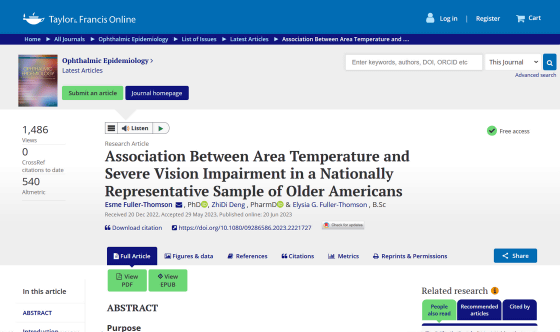Research shows that people living in areas with high temperatures are more likely to suffer from severe visual impairment, and global warming may worsen people's eyesight.

Rising temperatures due to climate change not only increase the risk of heat stroke, but also affect a wide range of health conditions, including human
Full article: Association Between Area Temperature and Severe Vision Impairment in a Nationally Representative Sample of Older Americans
https://doi.org/10.1080/09286586.2023.2221727

Higher average temperature linked to serious | EurekAlert!
https://www.eurekalert.org/news-releases/994061
Climate change could raise risk of vision impairment: study | CTV News
https://www.ctvnews.ca/climate-and-environment/could-climate-affect-our-eyes-canadian-study-finds-higher-temperatures-linked-with-vision-impairment-1.6465207
Visual impairment affects more than 12 million Americans over the age of 40, the majority of whom are over the age of 65. Including the costs of medical services and nursing care caused by visual impairment, as well as indirect costs such as lost productivity, visual impairment causes losses of approximately $35 billion (approximately 5.13 trillion yen) annually. thing.
Studies have shown that rising temperatures are associated with an increase in the incidence of conjunctivitis , as well as an increase in the number of emergency ophthalmological consultations. It has been suggested that it may have an adverse effect on the eyes.

A research team from the University of Toronto in Canada collected data from
In addition to the test subjects' answers, the research team analyzed the average temperature in the county where the test subjects were born, which was determined from weather data from the National Oceanic and Atmospheric Administration , to investigate the relationship between the average temperature in the place where they have lived since birth and visual impairment. Did.
The results showed that people living in counties with average temperatures between 10 degrees Celsius and less than 12.7 degrees Celsius were more likely to have visual impairments than those living in the coolest counties in the dataset, counties with average temperatures below 10 degrees Celsius. A 14% higher risk was found. This number gradually increases, with a 24% risk for those living in counties where the average temperature is 12.7 degrees Celsius to less than 15.4 degrees Celsius, and a 24% risk for those living in counties where the average temperature is 15.5 degrees Celsius or higher. 44% higher, the research team reported.
The association between severe visual impairment and average temperature was seen regardless of the subject's age, gender, income, and education level, but the association was particularly strong among subjects aged 65 to 79, men, and white people. Although this study merely investigated the association and did not prove causation, the research team believes that exposure to ultraviolet rays, air pollution, and the decomposition of folic acid caused by high temperatures may be the cause. thinking about.

'Serious visual impairment increases the risk of falls and fractures, negatively impacting the quality of life of older adults,' said study co-author ZhiDi Deng. We have suffered losses of billions of dollars (several trillion yen).Therefore, the relationship between temperature and visual impairment is quite worrisome.''
'We found that the relationship between visual impairment and temperature was consistent across many demographic factors, including income,' said Elysia Fuller-Thomson, a graduate student at the University of Toronto and lead author of the paper. ``Such a link between visual impairment and average temperature would be very worrying if future research shows that there is a causal relationship.'' 'This is expected. It will be important to monitor whether the prevalence of visual impairment in older adults increases in the future.'
Related Posts:
in Science, Posted by log1h_ik







